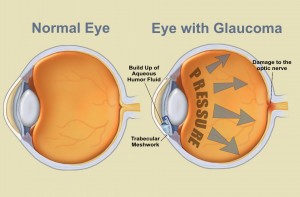Glaucoma is one of the leading causes of blindness in the United States. Glaucoma is the name for a group of eye diseases that damage the optic nerve, which may cause loss of vision. Abnormally high pressure inside your eye (intraocular pressure) usually, but not always, causes this damage. People with with this disease lose side (peripheral) vision. If not treated, vision loss may get worse, leading to total blindness over time.
Understanding Glaucoma : Types of Glaucoma
1 . The most common type is Primary open-angle glaucoma which has no noticeable signs or symptoms except:
- Gradual loss of peripheral vision, usually in both eyes
- Tunnel vision in the advanced stages
2 . The second type is Closed-angle glaucoma, the iris which is the colored part of the eye and the lens block movement of fluid between the chambers of your eye. This causes pressure to build up and the iris to press on the drainage system of the eye. This form of glaucoma is less common, symptoms include:
- Eye pain
- Blurred vision
- Halos around lights
- Reddening of the eye
- Nausea and vomiting (accompanying the severe eye pain)
3 . The third type is Congenital glaucoma which is the most rare, this form is the one that some infants are born with, noticeable symptoms are :
- Watery eyes
- Sensitivity to light
- Rubbing of eyes
- Squinting
- Keep eyes closed much of the time
Diagnosis and treatment
Unfortunately this disease does not have a cure that’s why it is important to have yearly eye exams, since this is the only way to diagnose this. Glaucoma is usually treated with eye drop medication, which you will more than likely need to take for the rest of your life. Treatment will not bring back vision that has been lost, but it can keep your vision from getting worse. Understanding glaucoma and early detection, treatment can prevent blindness. See your doctor if you notice any change in vision or blind spots.



